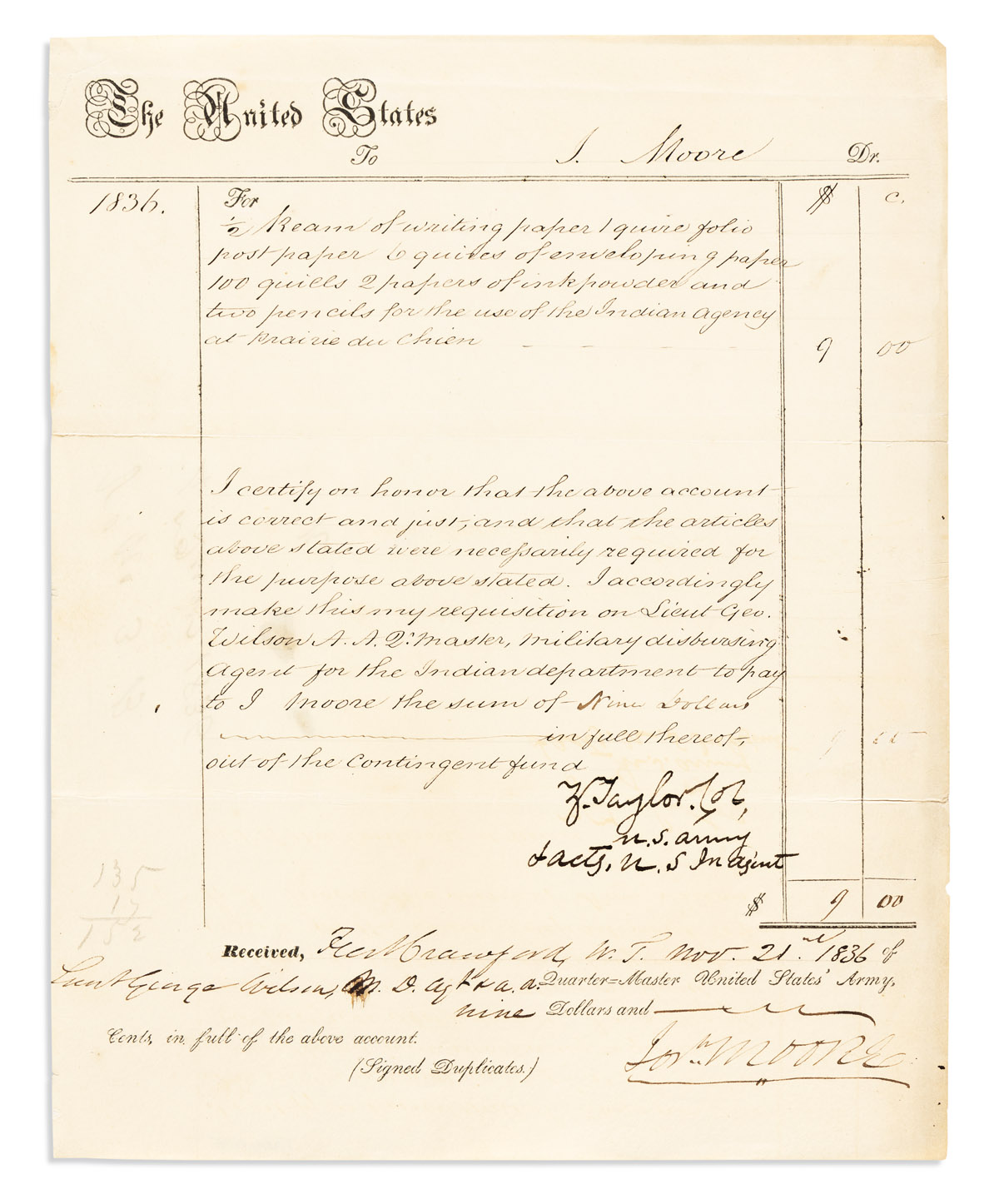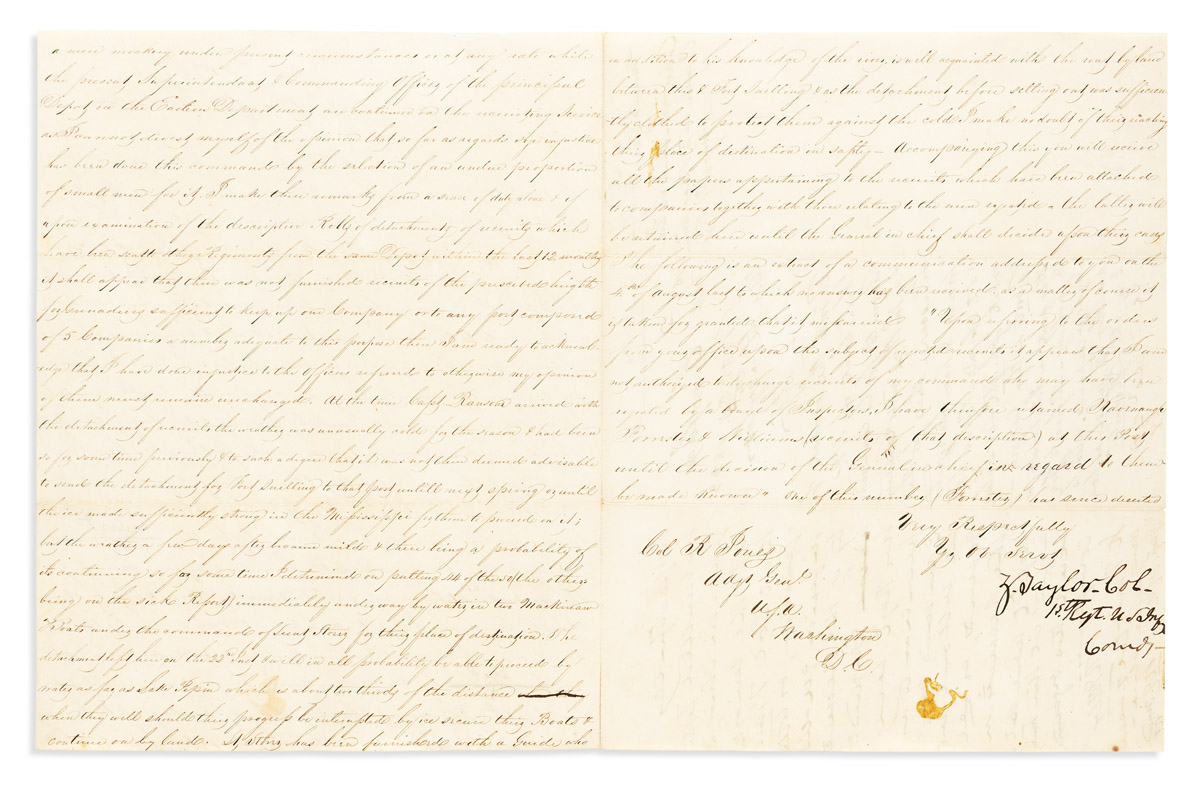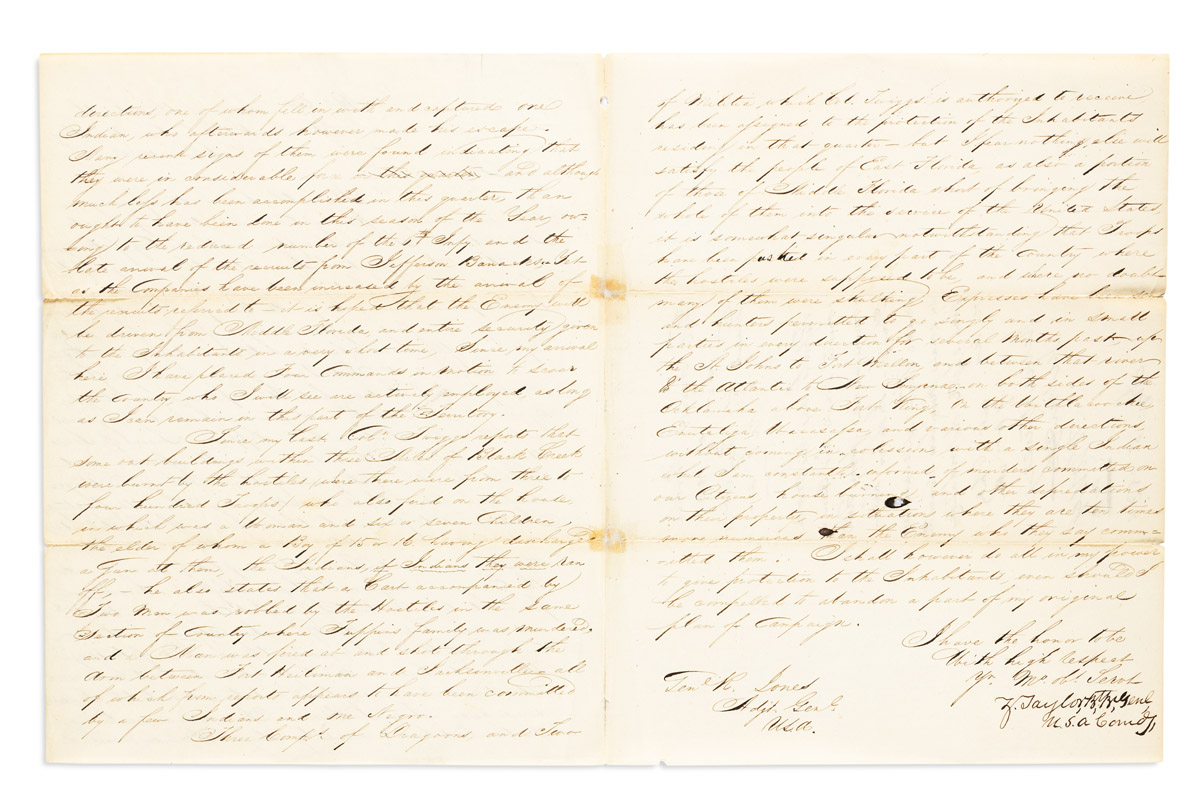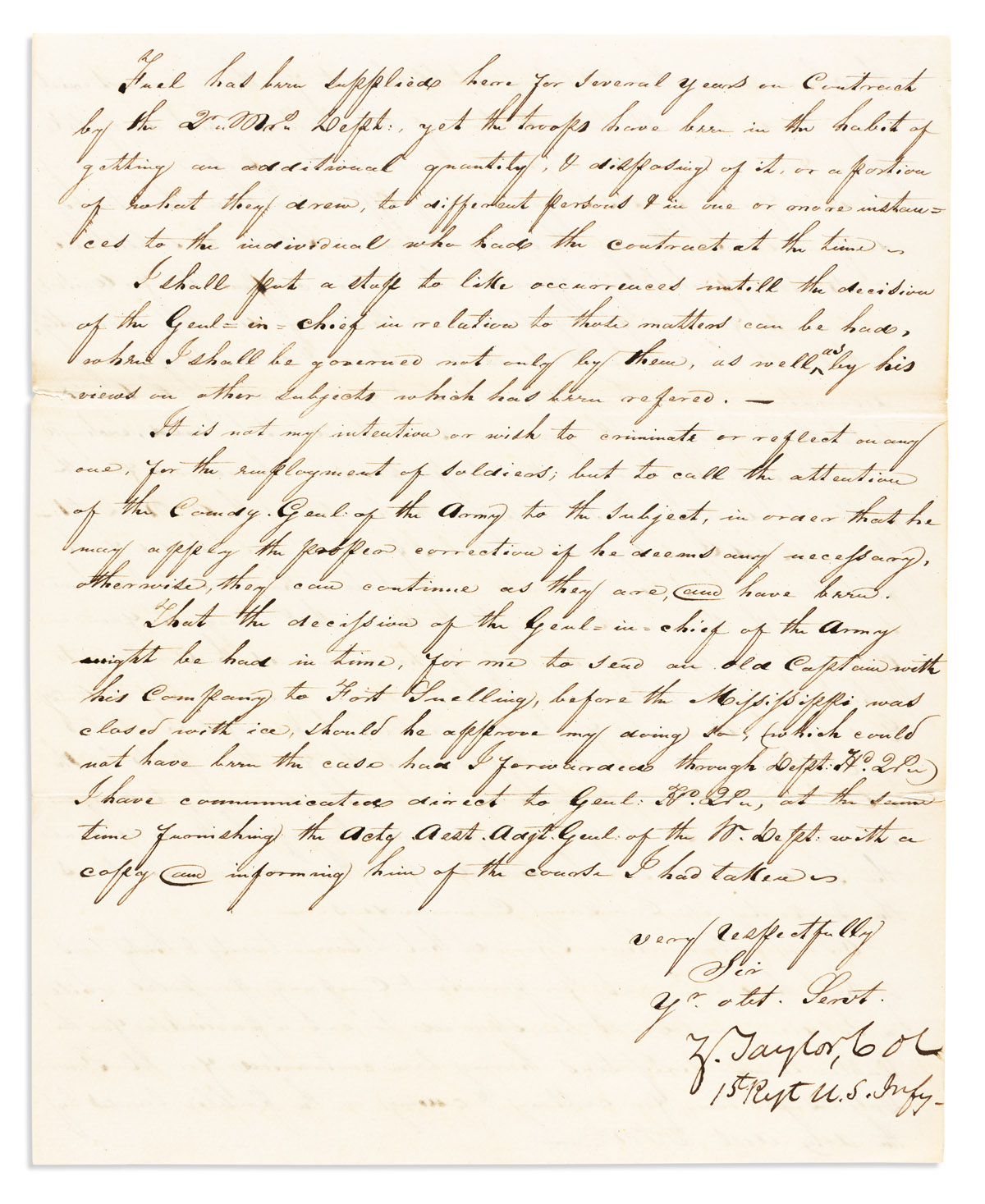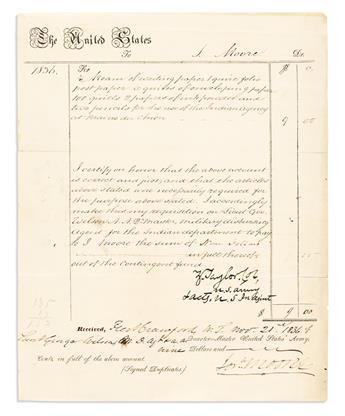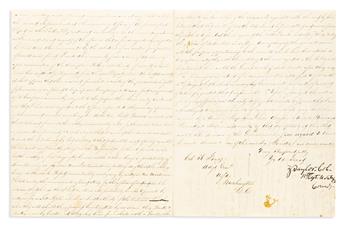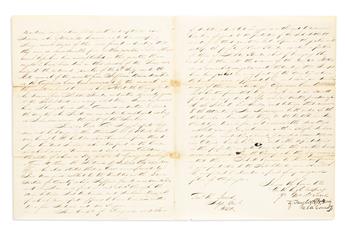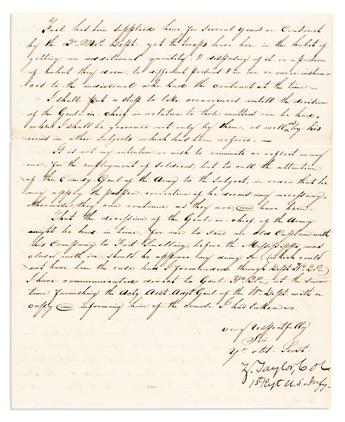Sale 2595 - Lot 4
Price Realized: $ 7,000
Price Realized: $ 8,750
?Final Price Realized includes Buyer’s Premium added to Hammer Price
Estimate: $ 6,000 - $ 9,000
WRITTEN DURING SECOND SEMINOLE WAR IN WAKE OF BLACK HAWK WAR TAYLOR, ZACHARY. Group of 4 items, each Signed, "Z. Taylor": Three Letters * Partly-printed Document. The letters, each to Adjutant General of the Army Roger Jones, requesting the authority and resources to move companies between posts to equalize the quality of garrisons, reporting on efforts to stop various abuses, complaining of the substandard recruits sent to Fort Crawford, describing various depredations on "inhabitants" by hostile Indians and promising to protect the former even at the expense of his campaign. Together 12 pages, 4to, each one or more folded sheets; the third with small cello tape repairs to fold intersections. The document, as Acting U.S. Indian Agent, certifying a requisition for paper and writing instruments for use by the Indian Agency. Countersigned by Acting Assistant Quartermaster George Wilson. 1 page, 4to; few closed separations at folds repaired with tissue verso, minor scattered soiling and offsetting. Vp, 1832-38; "Fort Crawford," 21 November 1836
Additional Details
"Fort Crawford," 23 August 1832: ". . . Experience has proved that the oftener troops are moved even from one station to another the more efficient they are, as it has the effect in a great measure of preventing that accumulation of large quantities of baggage . . . when they are permitted to remain for several years at the same station, particularly if it is a frontier one. Frequent movements . . . along the upper Mississippi and the rivers emptying into it through the Indian Country, would not only have the effect of making them respect, but fear us & as a matter of course, would be the means of keeping them quiet. Such movements not only invigorate the officers & men, but at the same time would serve to instruct the former in the important duties of moving & encamping troops; in what ought to be considered an enemy's country. . . .
"I should not have hesitated on my arrival here from the campaign, in relieving one of the companies at Fort Snelling with one from this post . . . had not Gen'l Atkinson, who was present at the time, advised or directed me not to do so until I referred the matter to the Gen'l-in-Chief . . . . In the present state of affairs, should the Indians in the vicinity of Forts Snelling & Armstrong become at any time dissatisfied & threaten hostilities toward the whites, I would not feel myself authorized to reinforce either of those garrisons . . . without an order to that effect from higher authority, let the emergency be what it might. . . ."
"Fort Frank Brooke," 21 December 1838: ". . . I found at Fort Fanning two companies of the 2nd Inf'y which had reached that place a few days before from the North and having learned on my arrival that the Indians had stopped a train of four wagons belonging to citizens near Waccasassa and robbed the drivers (Negroes) of their clothing and wagon covers, . . . I determined to proceed to this place with the Infantry and Dragoons . . . and have the country between the Suwannee and Tallahassee completely scoured and the enemy driven from it before I left it . . . . Several reconnoitering parties had been sent out by Major Noel . . . one of whom fell in with and captured an Indian, who afterward however made his escape. Many recent signs of them were found indicating that they were in considerable force . . . . [I]t is hoped that the enemy will be driven from Middle Florida, and entire security given to the inhabitants in a very short time. . . .
". . . Col. Twiggs reports that some outbuildings within three miles of Black Creek were burnt by the hostiles (where there were from three to four hundred troops) who also fired on the house, in which was a woman and six or seven children . . . . The Indians, if Indians they were, ran off; he also states that a cart accompanied by two men was robbed by the hostiles . . . and a man was fired at and shot through the arm between Fort Heilman and Jacksonville--all of which from reports appears to have been committed by a few Indians and one Negro. . . . I am constantly informed of murders committed on our citizens, house burned and other depredations on their property, in situations where they are ten times more numerous than the enemy who they say committed them. I shall however do all in my power to give protection to the inhabitants even should I be compelled to abandon a part of my original plan of campaign."
"I should not have hesitated on my arrival here from the campaign, in relieving one of the companies at Fort Snelling with one from this post . . . had not Gen'l Atkinson, who was present at the time, advised or directed me not to do so until I referred the matter to the Gen'l-in-Chief . . . . In the present state of affairs, should the Indians in the vicinity of Forts Snelling & Armstrong become at any time dissatisfied & threaten hostilities toward the whites, I would not feel myself authorized to reinforce either of those garrisons . . . without an order to that effect from higher authority, let the emergency be what it might. . . ."
"Fort Frank Brooke," 21 December 1838: ". . . I found at Fort Fanning two companies of the 2nd Inf'y which had reached that place a few days before from the North and having learned on my arrival that the Indians had stopped a train of four wagons belonging to citizens near Waccasassa and robbed the drivers (Negroes) of their clothing and wagon covers, . . . I determined to proceed to this place with the Infantry and Dragoons . . . and have the country between the Suwannee and Tallahassee completely scoured and the enemy driven from it before I left it . . . . Several reconnoitering parties had been sent out by Major Noel . . . one of whom fell in with and captured an Indian, who afterward however made his escape. Many recent signs of them were found indicating that they were in considerable force . . . . [I]t is hoped that the enemy will be driven from Middle Florida, and entire security given to the inhabitants in a very short time. . . .
". . . Col. Twiggs reports that some outbuildings within three miles of Black Creek were burnt by the hostiles (where there were from three to four hundred troops) who also fired on the house, in which was a woman and six or seven children . . . . The Indians, if Indians they were, ran off; he also states that a cart accompanied by two men was robbed by the hostiles . . . and a man was fired at and shot through the arm between Fort Heilman and Jacksonville--all of which from reports appears to have been committed by a few Indians and one Negro. . . . I am constantly informed of murders committed on our citizens, house burned and other depredations on their property, in situations where they are ten times more numerous than the enemy who they say committed them. I shall however do all in my power to give protection to the inhabitants even should I be compelled to abandon a part of my original plan of campaign."
Exhibition Hours
Exhibition Hours
Aliquam vulputate ornare congue. Vestibulum maximus, libero in placerat faucibus, risus nisl molestie massa, ut maximus metus lectus vel lorem.



